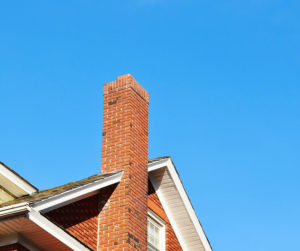While fireplaces and chimneys are built to last, they do not always work as efficient over time. Improper construction, damage, and operator error can all contribute to the fireplaces from burning as safely and efficiently. When you experience any sort of performance or drafting problems, you should turn to a chimney sweep for help!
How chimneys work
 Chimneys are able to draft because of hot air. When a fire is lit in the firebox, the air inside the chimney begins to get warmer – and less dense – than outside air. As the air gets warmer, it begins to rise. As the warm air rises, cooler air is drawn into the fireplace to fan the fire. This further pushes the warm air up the chimney. While this seems simple, even small changes can really make the draft inside your chimney. Some examples are fireplace design, chimney construction, fuel source, or maintenance.
Chimneys are able to draft because of hot air. When a fire is lit in the firebox, the air inside the chimney begins to get warmer – and less dense – than outside air. As the air gets warmer, it begins to rise. As the warm air rises, cooler air is drawn into the fireplace to fan the fire. This further pushes the warm air up the chimney. While this seems simple, even small changes can really make the draft inside your chimney. Some examples are fireplace design, chimney construction, fuel source, or maintenance.
What’s wrong with my chimney?
There is no one-size-fits-all solution to chimney drafting issues. However, there are a number of common problems that can affect fireplace performance including:
- Damper – Is your damper open all the way? Throat dampers can rust or experience damages over time, making them difficult to open and close. Likewise, chains and pulleys can break, leaving the damper stuck open, closed, or somewhere in between.
- Firewood – The kind of firewood you use in your fireplace can significantly impact its performance. Wood that is freshly cut, from soft wood trees such as firs or pines, or has recently gotten wet from snow or rain will burn differently than well-seasoned, dry firewood from hard wood trees.
- Chimney blockages – Debris in the chimney such as leaves, animal nesting materials, soot and ash buildup, and restrict airflow can all prevent the chimney from drafting properly.
- Chimney height – Chimney draft dynamics rely heavily on the height of the chimney. A chimney that is too tall or too short can create pockets of positive or negative air pressure. This makes it difficult for your fireplace to draw in air or forcing air down the chimney.
- Surrounding structures – If nearby trees, building, roof components, or house additions are too tall or close to the chimney, this prevent proper drafting.
- Airtight house – While it might seem counter intuitive, houses are not meant to be airtight. An airtight house can lead to sluggish fires or smoke that doesn’t draw up the chimney.
- Design problem – Some fireplaces or chimneys have really poor design from the beginning or they were built using improper materials. This also causes drafting and performance problems.
Diagnosing chimney performance problems
Unfortunately, a quick Google search, trimming a new trees, or adjusting the damper is often not enough to get a chimney drafting properly. When a fireplace is experiencing performance problems, the best way to diagnose the source of the issue is call a CSIA certified chimney sweep.
At Jack Pixley Sweeps, we have trained and certified chimney technicians to diagnose your draft problems and offer you quality solutions. Whether its cleaning the flue, installing a top sealing damper, or reworking the chimney to improve the draft, we can help restore your fireplace and chimney. Contact us today to schedule your next chimney inspection or learn more about chimney draft dynamics!
